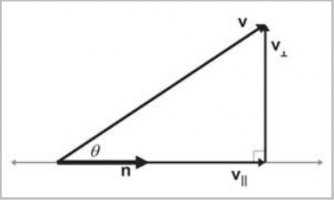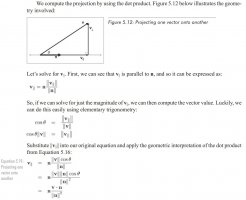TheTraveler
New member
- Joined
- May 7, 2022
- Messages
- 4
Hi all!
I was studying a demonstration about vectors projections and it starts with this image:

The demonstration starts solving by v|| and it says that:
v∥=n(∥v∥∥/∥n∥)
and this is the unclear step.
I tried to unroll this step (which is not explained in the demonstration) and I thought about using the dot product:
n⋅v∥=∥n∥∗∥v∥∥∗cosθ
and, because the two vectors are parallels, the angle is 0 and the cosine is 1, so it results:
n⋅v∥=∥n∥∗∥v∥∥
but from here on out I don't really understand how to proceed to obtain the first step. Any suggestion? I know it's probably a stupid thing but I cannot figure it out ?
I was studying a demonstration about vectors projections and it starts with this image:

The demonstration starts solving by v|| and it says that:
v∥=n(∥v∥∥/∥n∥)
and this is the unclear step.
I tried to unroll this step (which is not explained in the demonstration) and I thought about using the dot product:
n⋅v∥=∥n∥∗∥v∥∥∗cosθ
and, because the two vectors are parallels, the angle is 0 and the cosine is 1, so it results:
n⋅v∥=∥n∥∗∥v∥∥
but from here on out I don't really understand how to proceed to obtain the first step. Any suggestion? I know it's probably a stupid thing but I cannot figure it out ?

